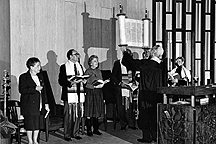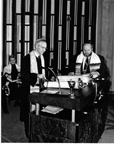





The Torah, commonly translated as "doctrine " or "instruction," can be broadly defined as encompassing all the teachings of Judaism. The Torah is technically divided into two parts: The Written Torah (or Mosaic Code) and the Oral Torah. Tradition tells that God gave these two branches of the Torah to Moses at Mount Sinai. The Written Torah refers to the first five books of the Bible: Genesis, Exodus, Leviticus, Numbers, and Deuteronomy. The Oral Torah consists of Talmudic teachings (Halakah and Aggadah) and subsequent rabbinic literature. When Jewish people refer to the Torah, however, they are usually referring to the Written Torah.
The Written Torah typically appears in the form of a scroll and is inscribed on parchment from a ritually clean animal. The Sephardim usually store Torah scrolls in a wooden box. The Torah scrolls in an Ashkenazi synagogue, in contrast, are typically covered by a mantle through the top of which protrude two staves known as atzei hayyim or "trees of life." Two finials or "rimmonim" are typically placed on top of these staves. Usually, a crown is incorporated into the design of the finials.

In the Synagogue, Torah Scrolls are stored in an ark. While the
style of arks has varied from era to era, they usually include
the motif of the Tablets of the Law, which signifies the laws
of the Torah. Since the eighteenth century, an eternal light or
ner tamid has been placed in front of the ark. In addition, an
array of candles (Ashkenazi tradition) or oil lamps (Sephardic
tradition) are typically hung over the ark. In the Ashkenazi tradition,
a hanging curtain called the parokhet is used to conceal the Torah
scrolls within the ark. Usually, a different parokhet is used
for weekdays, the Sabbath, festivals,
and the High Holidays. While the parokhets differ in terms of
decoration, they typically include various floral motifs and symbols
from the first Temple.
The Torah is divided into 54 portions and is read in annual cycles. One portion, and sometimes two, are read on each Sabbath. On festivals, a special portion dealing with the theme of that festival is read from one scroll and the relevant portion of Numbers 28:16-29:39 is read from another. A weekly Torah portion is called a Sidrah. These portions are further subdivided into seven sections, each of which is called a Parashah. Usually, the reading of the Torah portion is followed by a reading from the Prophets, known as the Haftarah.

As is evident from its treatment during a service, the Torah is a holy object which is highly valued by the Jewish people. Both before and after it is read, the Torah is carried around the synagogue in procession. During this procession, the congregation stands and individuals typically kiss the Torah, by touching their hand or tallit to the mantle and kissing what has touched the Torah. In order for the Torah to be read, ten adults must be present. This is called a minyan. In the Reform tradition, these individuals can be either men or women who are of Bar Mitzvah or Bat Mitzvah age or greater. In the Orthodox tradition, however, the minyan must consist solely of men.

When the Torah is read, it is placed on a reading table which is located on the bimah. This desk is covered by an embroidered cloth known as a mappah. In Judaism, it is considered an honour to be called up to make a blessing over the Torah. This honour is call an aliyah which means "going up." The number of aliyot vary from festival to festival. On Sabbath, for example, seven aliyot are granted. Whereas in the Orthodox tradition only men can bless over the Torah, in Reform Judaism both men and women can be given aliyot. When a person is reading from the Torah, it is very important that he or she pronounces each word properly. If he or she reads a word incorrectly, so that its meaning is changed, he or she must repeat it in the correct manner. It is forbidden to touch the parchment of the Torah. Consequently, a pointer or yad ("hand") is used.
The Torah can only be read from a scroll which is kosher or "fit for use." If even one letter is missing from the scroll, then it is considered to be pasul ("unfit"). If, during a service, it is discovered that a scroll is pasul then it must be returned to the ark and another scroll taken out. The Torah reading is then continued with the second scroll from the place where the mistake is discovered.
| Back to Glossary | Jewish Holidays | Treasures | Life Cycle | Home Page |